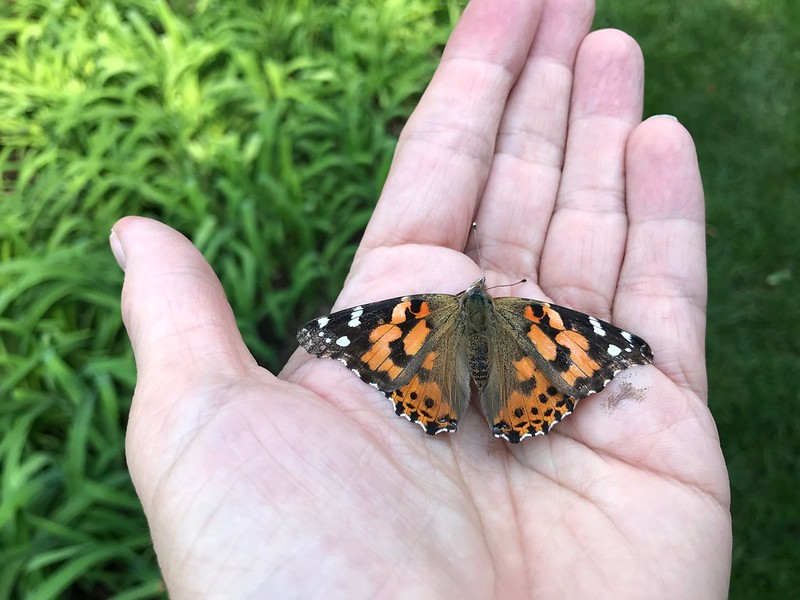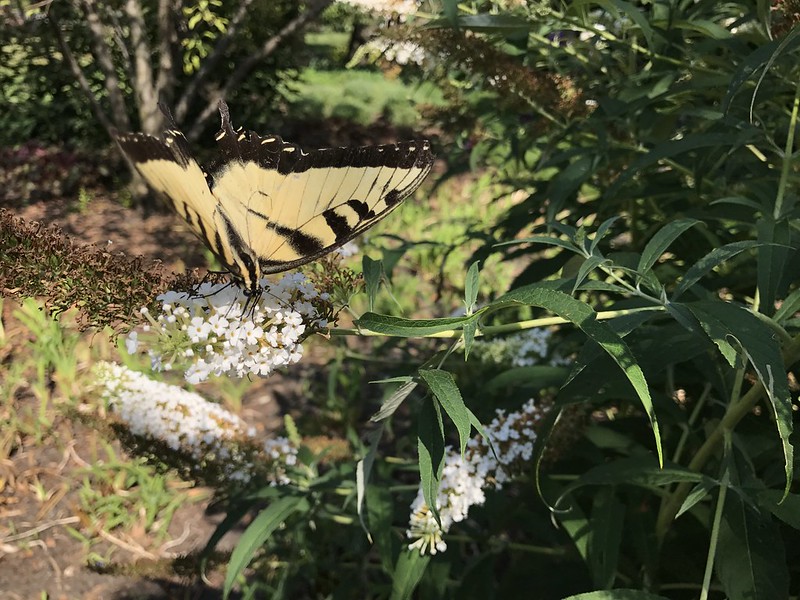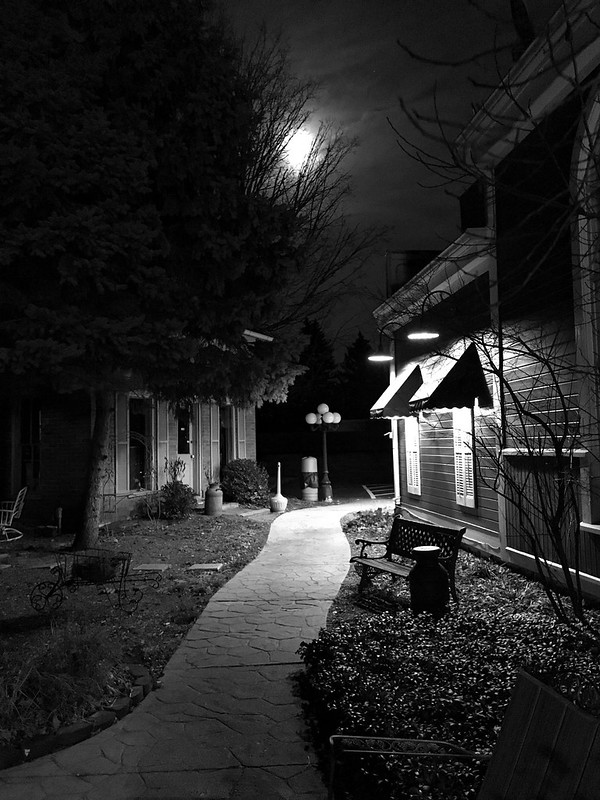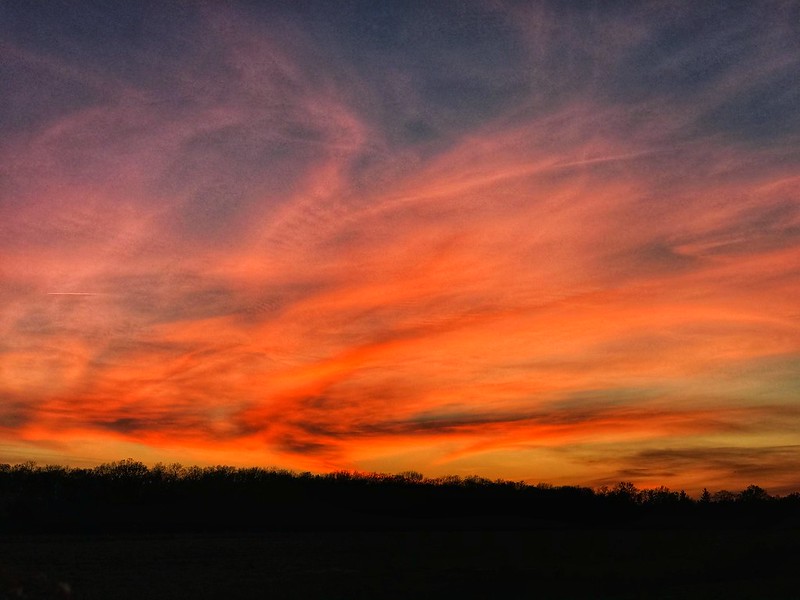Combine clear winter air, reflecting clouds, and sunset for vibrant color.
Category Archives: Photography
Sea smoke on Lake Michigan
Elk, or wapiti, in Pennsylvania
The “Full Cold Moon”
Sunset from Coffee Creek Park in Chesterton, Indiana
The call of sandhill cranes at Jasper Pulaski in Indiana
Oh, deer (signs of the times)
Death of a painted lady, or murder at the butterfly bush
On Saturday, I witnessed a murder.
The Hemaris moths are gone (presumed dead), and all that seemed to be left are the skippers and an occasional monarch. On Saturday, though, a hungry painted lady appeared. I spent an hour or more trying to take photos of this favorite of mine, but I’ve noticed they tend to turn their wide rumps toward me. I try not to take this personally, nor the apparent glare of the skipper that landed on my finger as I raised the phone.



At some point after the painted lady landed on an upper branch, I noticed it beating its wings furiously. I looked and could see only a bit of yellow-green against the purple flowers, but the painted lady seemed stuck. I broke the sprig off with the butterfly still attached. The poor thing went still, its poor legs curled up. I discovered the yellow-green thing had legs. I later decided it was a kind of well-named “ambush bug” — a tiny but formidable garden predator that doesn’t discriminate between pests and pollinators. Or a crab spider.1



This was one of the few times I’ve interfered with nature — something I’d normally not do and would not recommend. I can only plead that I was distraught over being deprived of my colorful little friend. I was reminded that the butterfly bush, so full of life in August, when dozens of moths, butterflies, and bees flitted about, can also be full of death. I have complicated feelings about the murder (anthropomorphism) of my new painted lady friend, but I won’t go into them here.
This painted lady appeared on Tuesday to console me (I’d taken the day off). In return, I tried to scout the remaining blossoms for lurking killers.


Now, on this last full day of summer, the one creature I saw, a painted lady, flew off when I approached and didn’t return. Another plant down the path that was crawling with a variety of bees only a couple of weeks ago is nearly motionless, with only a few stragglers lethargically tapping into its flowers. There wasn’t even the chatter of birds to relieve the loneliness of the garden past its seasonal prime.
And so summer ends and autumn begins.
1 I’ve seen crab spiders since at Perennial Garden, usually killing skipper butterflies, never Japanese beetles.
Snowberry and hummingbird clearwings, and summer winding down
During the first half of August last year, I was thrilled to discover not only butterflies at Perennial Garden, but also the little fairy moths known as snowberry clearwings (Hemaris diffinis). I never expected to see anything like them here.
I found that great, Eastern tiger, and black swallowtails; red-spotted purples; painted ladies; silver-spotted and fiery skippers; bees; clearwings; and even a hummingbird or two love a particular butterfly bush at the garden. This bush, which had been cut down to the ground after last summer, didn’t bloom fully until early to mid-August — I started checking as early as May! On my brief visits, I never saw clearwings, so I braced myself for disappointment.











I started seeing a few clearwings a couple of weeks ago Thursday. When I pedaled over the Saturday before last at 3 p.m., the bush was swarming with life. I noticed that among the snowberry clearwings a few hummingbird clearwings, with their fuzzy green upper backs, were making an appearance. I was in heaven. I love these guys — even after I noticed they were buzzing one another and throwing each other off choice branches or blossoms.


By Saturday there were fewer of the snowberry clearwing moths under the increasingly cloudy skies. I was happy to have seen so many the day before.
I’d made one of the photos I’d taken the background image on my iPhone screen. I’ve changed phones since then, but I haven’t changed the image. I took a closer look at it — and realized that particular photo from last year is of a hummingbird moth (Hemaris thysbe). How did I never notice that? It had the species’ distinctive fuzzy green upper back and lacks the light band near the skirt. While bemoaning that I hadn’t seen any Hemaris thysbe at this butterfly bush, I’d been staring at a photo of one I’d taken a year ago. Brilliant.

Last Tuesday I left work early for a doctor’s appointment and managed to get to the garden by 5 p.m. I was happy to have this unexpected opportunity to visit my little fairy moths — especially since they live only a few weeks.
The bush wasn’t buzzing like it’d been on Saturday, and there weren’t any large butterflies around—but there were enough moths for me to get a few photos and videos, including one in slow motion. I don’t know why I didn’t think of that sooner, except I am still trying to get a sharp closeup photo.
While I was standing watching a handful of moths flitting around, I heard a “bzzzzzzzzt” behind my head. I turned to find myself face to face with a hummingbird, separated by only a foot and a half or two feet of space.
As I was trying to get myself together (“Where’s the phone? Where’s the camera app?”), she buzzed around me to take a couple of quick sips at the bush. I have only these mid-distance shots and a memory now.


Now there’s only about an hour between the time I get home, change, get my bike out, and ride over, and sunset. By that hour, the Hemaris moths are few if any. The other day I was watching a hummingbird clearwing when a snowberry clearwing attacked it and carried it away.
I wish I could tell them there are plenty of blossoms to go around for the little time they have left.
Signs of the times: First in a series
In the United States you don’t have to go far to see a sign. Signs are everywhere. We have directional signs. Commercial signs. Warning signs. Not permitted signs. Educational signs. Monument signs. Signs tacked onto other signs. Confusing signs. Signs meant to clarify other signs. We even have doors, walls, and sides of buildings transformed into signs. If Saturnian neighbors were to descend upon Earth, they might note that Americans seem to be as inordinately fond of signs as God is of beetles (J.B.S Haldane: “The Creator would appear as endowed with a passion for stars, on the one hand, and for beetles on the other . . .”).
When my aunt and I returned to Washington, D.C., from a pilgrimage to Monticello, Michie Tavern, and Ash Lawn in the early 1990s, she pointed out that the highway was unspoiled by billboards, per Virginia law. Drive through northwest Indiana on I-90 and as your eyes are assaulted by the bleakness of the ubiquitous power towers planted in the industrial landscape, they’ll find no relief in the onslaught of billboards — giant signs touting cheap fireworks (legal in Indiana but not neighboring Illinois), attorneys whose faces are blown up to epic proportions (Personal injury? Car accident? Custody issues? Mesothelioma?), “gentlemen’s clubs,” and other local businesses. (The biblical Daniel could have no idea how “Lion’s Den” would come to be used.)
All of these are in addition to the usual interstate signs — exits, speed limits, land endings and closings, construction (always construction), and other miscellaneous information a driver needs to know while navigating defensively among fellow drivers passing and weaving in and out of narrow lanes at 80 miles per hour.
Signs abound even in nature sanctuaries such as parks and wildlife areas. In addition to entrance monuments, maps, and trail signs, these may include rules, warnings, pleas not to feed the wildlife, and fishing and hunting restrictions. If you’re near a nuclear power plant, you’ll want to check out the signs telling you what to do if something goes terribly, terribly wrong. (Hint: Your burning flesh should tune into one of these radio stations.)

If you’re in the United States and you’re outside your home, chances are good you’re not too far from a sign. (It may be no more than the scrawled one taped to the office printer, “OUT OF ORDER. SERVICE CALLED.”)
Signs even lurk under your feet.




As we begin this journey at some point, remember:











